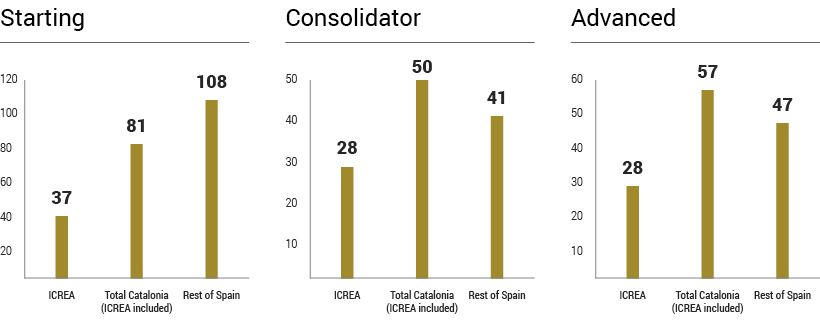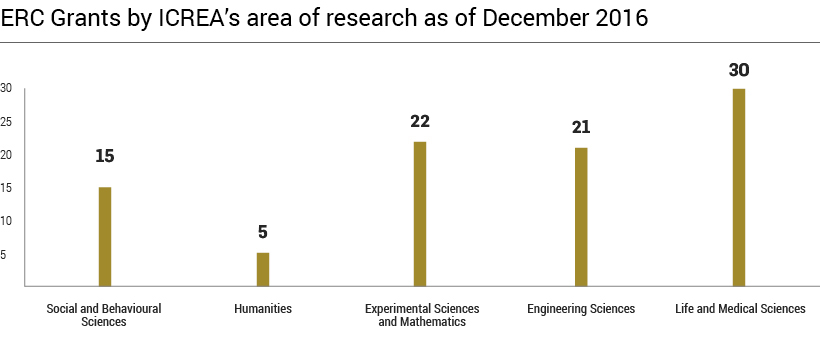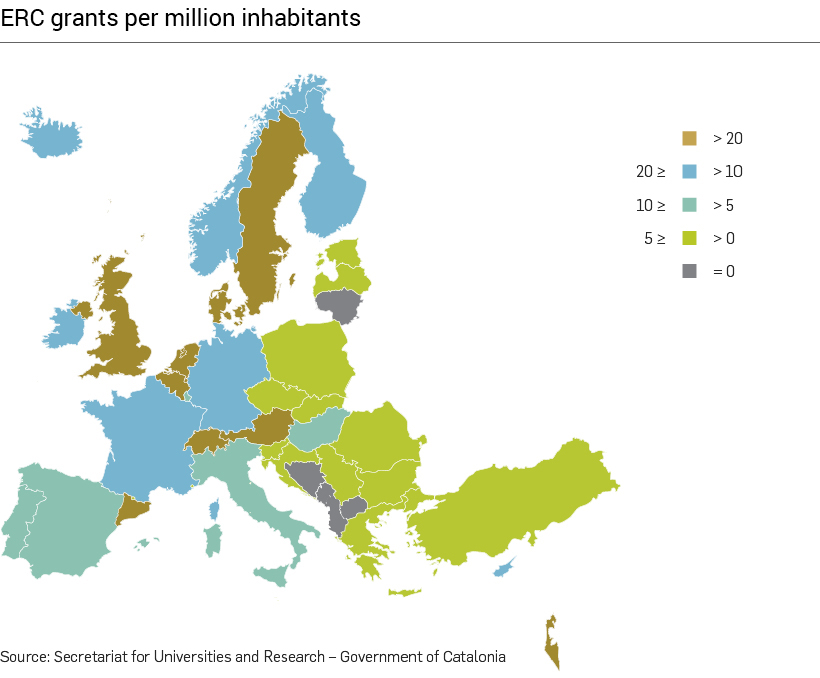European Research Council (ERC) grants support individual researchers who wish to pursue frontier research. In particular, the ERC encourages proposals that cross disciplinary boundaries, pioneering ideas that address new and emerging fields, and applications that introduce unconventional, innovative approaches. The ERC funding schemes are open to researchers of any nationality or age who wish to carry out their frontier research in the 28 EU member states or associated countries.

There are three ERC core funding schemes: Starting Grants, Consolidator Grants, and Advanced Grants, and two additional schemes: Proof of Concept and Synergy Grants. The latter did not open in 2016.
Distribution of ERC grants as of December 2016
ICREA’s share of ERC grants


ICREA’s ERC awardees in 2016
Consolidator Grants (CoG)
CoG are designed to support researchers at the stage at which they are consolidating their own independent research team or programme. The scheme will strengthen independent and excellent recently created research teams. ICREA’s awardees in 2016:
Núria Aliaga | Institut de Ciència de Materials de Barcelona (CSIC-ICMAB) | Physical Sciences & Engineering
Tmol4TRANS – Efficient electronic transport at room temperature by T-shaped molecules in graphene-based chemically modified three-terminal nanodevices

Tmol4TRANS aims to create operative molecular systems that will efficiently be inserted in three-terminal nanodevices to function as transistors at room temperature (RT).
In the front-line of molecular electronics, the implementation of functional nanodevices in present technologies is mainly hampered by crucial unresolved issues like: a) reliability of RT experiments on molecular transistors; b) absence of controlled methodologies to deposit single molecules at specific sites; c) low conductance values and d) difficulties in achieving effective three-terminal devices (BJTs/FETs). Such hindrances involve the nature of the molecules, the absence of controlled deposition methodologies at the nanoscale and the poor stability/contacts between molecules and electrodes.
Stable two-terminal nanodevice based on few-layer graphene and containing a Curcuminoid molecule (CCMoid) that I made has shown reasonable molecular conductance at RT, where the CCMoid anchors to the electrodes by pi-pi stacking.
The specific goals of Tmol4TRANS are:
1) to synthesize multifunctional molecules base on “T-shaped” CCMoids and Porphyrin derivatives (PPDs) allowing efficient attachments to electrodes;
2) to fabricate chemically functionalized hybrid graphene transistors;
3) to establish a reliable methodology for positioning the molecules between the electrodes;
4) to investigate the conductance enhancement of the final systems, and
5) to provide the possibility of spin-dependent transport properties by binding such molecules to magnetic metals.
Here, the preparation of nanodevices involves feedback-controlled burning technique for the formation of the few-layer graphene electrodes (source/emitter and drain/collector) and the chemical functionalization of the gate/base, where T-shaped molecules will be fixed by click-chemistry.
Tmol4TRANS would have a direct impact in Molecular Electronics and Spintronics, as well as in the broader scope of nanoelectronics.
Julian di Giovanni | Universitat Pompeu Fabra (UPF) | Social Sciences & Humanities
Global Production Networks and Macroeconomic Interdependence
Researchers and policymakers alike have highlighted the potential efficiency gains of a global production structure. However, such linkages also raise the possibility of risks. This project tackles both empirical and theoretical challenges in incorporating the microeconomic structure of trade and international production networks in the study of the propagation of shocks internationally, and their impact on macroeconomic interdependence. Using newly constructed micro-level datasets, the projeoct will provide quantitative analysis of the importance of the linkages in multicountry general equilibrium models of trade.
First, using firm export and imported-input linkages, the project provides a novel model-based estimation strategy to identify the role of country and firm-level shocks, and the implications of these estimates for the transmission of shocks across borders. By using structural trade models to estimate shocks at the firm level and studying the implications for the transmission of shocks across borders, this research helps bridge the micro-macro nexus in international economics.
Second, the project takes an even more granular focus by studying the role of firm-to-firm production linkages in transmitting shocks across countries. To do so, it exploits a novel matching procedure between a country’s administrative dataset and cross-country firm-level data. The project further builds on these data by adding in domestic bank-firm relationships. This strategy allows for the study of how financial shocks are exported abroad via firms’ trade and multinational linkages.
Third, the project incorporates the insights from the empirical work into a full-scale multicountry general equilibrium model of trade, which allows for firm-level heterogeneity and microeconomic and macroeconomics shocks. It uses the model for a quantitative study of the cross-country transmission of the different shocks via trade. This permits the performance of counterfactuals and examination of the impact of policies, such as how opening to trade impacts macroeconomic interdependence.
Toni Gabaldón | Centre de Regulació Genòmica (CRG) | Life Sciences

The traditional view is that species and their genomes evolve only by vertical descent, leading to evolutionary histories that can be represented by bifurcating lineages. However, modern evolutionary thinking recognizes processes of reticulate evolution, such as horizontal gene transfer or hybridization, which involve total or partial merging of genetic material from two diverged species. Today it is widely recognized that such events are rampant in prokaryotes, but a relevant role in eukaryotes has only recently been acknowledged.
Unprecedented genomic and phylogenetic information and recent work from others and us have shown that reticulate evolution in eukaryotes is more common and have more complex outcomes than previously thought. However, we still have a very limited understanding of what are the impacts at the genomic and evolutionary levels.
To address this, I propose to combine innovative computational and experimental approaches.
The first goal is to infer patterns of reticulate evolution across the eukaryotic tree, and relate this to current biological knowledge.
The second goal is to trace the genomic aftermath of inter-species hybridization at the
i) long-term, by analysing available genomes in selected eukaryotic taxa,
ii) mid-term, by sequencing lineages of natural fungal hybrids, and
iii) short-term, by using re-sequencing and experimental evolution in yeast.
A particular focus is placed on elucidating the role of hybridization in the origin of whole genome duplications, and in facilitating the spread of horizontally transferred genes. Finally results from this and other projects will be integrated into emerging theoretical frameworks.
Outcomes of this project will profoundly improve our understanding of reticular processes as drivers of eukaryotic genome evolution, and will impact other key aspects of evolutionary theory, ranging from the concept of orthology to the eukaryotic tree of life.
Albert Guillén i Fàbregas | Universitat Pompeu Fabra (UPF) | Physical Sciences & Engineering
Information Theory with Uncertain Laws
Shannon’s Information Theory paved the way for the information era by providing the mathematical foun- dations of digital information systems. A key underlying assumption of Shannon’s key results is that the probability law that governing system is known, allowing to optimize the codebook and decoder accordingly. There are a number of important situations where perfectly estimating the system law is impossible; in these situations the codebook and decoder must be designed without complete (or no) knowledge of the system law. The vast majority of the Information Theory literature makes strong simplifying assumptions on the model. Theoretical studies that provide a general treatment of information processing with uncertain laws are hence urgently needed. For general systems, standard asymptotic techniques cannot be invoked and new techniques must be sought. A fundamental understanding of the impact of uncertainty in general systems is crucial to harvesting the potential gains in practice.
This project is aimed at contributing towards the ambitious goal of providing a unified framework for the study of Information Theory with uncertain laws. A general framework based on hypothesis testing will be developed and code designs and constructions that naturally follow from the hypothesis testing formulation will be derived. This unconventional and challenging treatment of Information Theory will advance the area and will contribute to Information Sciences and Systems disciplines where Information Theory is relevant.
A comprehensive study of the fundamental limits and optimal code design with law uncertainty for general models will represent a major step forward in the field, with the potential to provide new tools and techniques to solve open problems in close disciplines. Therefore, the outcomes of this project will not only benefit communications, but also areas such as probability theory, statistics, physics, computer science and economics.
Frank Koppens | Institut de Ciències Fotòniques (ICFO) | Physical Sciences & Engineering
TOPONANOP – Topological NanoPhotonics
TOPONANOP’s vision is to exploit the extraordinary topological properties of novel quantum materials in order to control light at the nanoscale in a radically new way.
One of the main objectives is to generate non-reciprocal nanoscale optical fields (plasmons) that propagate in only one direction and implement topologically protected plasmons such that they move around defects and corners. At the same time, visualizing and controlling electromagnetic excitations will be used as a tool to unravel extraordinary phenomena in exotic quantum materials.
Topological nano-photonics is a new paradigm for novel quantum materials and will enable novel future applications in miniaturized photonic isolators, diodes and logic circuits and could lead to completely new concepts for communication systems, optical transistors and optical information processing.

Gerasimos Konstantatos | Institut de Ciències Fotòniques (ICFO) | Physical Sciences & Engineering
HEINSOL: Hierarchically Engineered Inorganic Nanomaterials from the atomic to supra-nanocrystalline level as a novel platform for SOLution Processed SOLar cells.
Solution processed inorganic nanocrystal (NC) materials have received enormous attention as an emerging technology to address the TW challenge in solar cells. These nanomaterials offer a unique opportunity for low-cost high efficiency all-inorganic solar cells. Despite the great efforts though, only a limited number of colloidal NC compounds has been successfully employed, which either rely on costly and scarce elements or toxic materials.
HEINSOL’s mission is to develop the first highly efficient, robust solution processed solar cell platform based on environmentally friendly, Earth abundant materials. To achieve this, HEINSOL undertakes a hierarchical approach to tailor the opto-electronic properties of inorganic NCs, starting from the control of composition and their properties at the atomic level and following up with further tailoring their optoelectronic properties via interactions at the supra-nanocrystalline level.
HEINSOL, at the atomic level, will develop novel doping schemes for colloidal NCs to tailor their electronic character as well as passivation schemes to reduce the density of unfavourable trap states. At the supra-nanocrystalline level, HEINSOL will explore novel nano-heterojunctions that cater for efficient charge separation and suppressed recombination, elements of paramount importance in high performance solar cells.
The microscopic properties of the NCs will be correlated with the macroscopic properties of the NC composites in operating devices, a methodology that will provide new insights on the underlying mechanisms at the nanoscale that govern the properties of those devices. The final goal is to introduce a new architectural platform for solution processed solar cells that will truly expand the material availability for the Photovoltaic Industry.
Massimiliano Stengel | Institut de Ciència de Materials de Barcelona (CSIC-ICMAB) | Physical Sciences & Engineering
MULTIFLEXO – Hierarchical multiscale modeling of flexoelectricity and related materials properties from first principles
Flexoelectricity, the coupling between an inhomogeneous deformation and the electrical polarization, has emerged a “hot” topic in modern materials science due to its cross-cutting relevance to many phenomena of fundamental and technological interest. Understanding the intriguing physics that governs its behaviour at the nanoscale is crucial to harnessing the potential of strain gradients in practical applications, and such a progress requires a substantial support from theory.
In spite of impressive recent advances, first-principles calculations of flexoelectricity remain technically challenging at several levels: first, the breakdown of translational lattice periodicity that a strain gradient entails is problematic to treat in the context of traditional electronic-structure methods; second, the stringent length- and time-scale constraints of direct quantummechanical approaches limit the applicability of these methods to real problems, which often involve complex sample shapes and morphologies.
This project is aimed at overcoming these obstacles from their very root, via the development of ground-breaking innovations in electronic-structure and multiscale methodologies, and at using these advances to address a number of pressing physical questions in the context of energy and information technologies.
In particular, the objectives of this project are:
(i) identifying the microscopic mechanisms that are most effective at delivering a strong flexoelectric response in a variety of materials;
(ii) understanding how these bulk effects are modified by size, shape and boundary conditions, and how they interact with other material properties;
(iii) supporting the experimental interpretation by critically assessing alternative physical interpretations of the observed effects (e.g. compositional gradients) and
(iv) exploring the functionalities enabled by strain gradients in complex materials systems, including 2D crystals, semiconductor nanowires and multiferroics.
Licia Verde | Universitat de Barcelona (UB) | Physical Sciences & Engineering
BePreSysE – Beyond Precision Cosmology: dealing with Systematic Errors
Over the past 20 years cosmology has made the transition to a precision science: the standard cosmological model has been established and its parameters are now measured with unprecedented precision. But precision is not enough: accuracy is also crucial. Accuracy accounts for systematic errors which can be both on the observational and on the theory/modelling side (and everywhere in between). While there is a well-defined and developed framework for treating statistical errors, there is no established approach for systematic errors.
The next decade will see the era of large surveys; a large coordinated effort of the scientific community in the field is on-going to map the cosmos producing an exponentially growing amount of data. This will shrink the statistical errors, making mitigation and control of systematics of the utmost importance. While there are isolated and targeted efforts to quantify systematic errors and propagate them through all the way to the final results, there is no well-established, self-consistent methodology.
To go beyond precision cosmology and reap the benefits of the forthcoming observational program, a systematic approach to systematics is needed. Systematics should be interpreted in the most general sense as shifts between the recovered measured values and true values of physical quantities.
I propose to develop a comprehensive approach to tackle systematic errors with the goal to uncover and quantify otherwise unknown differences between the interpretation of a measurement and reality. This will require to fully develop, combine and systematize all approaches proposed so far, develop new ones to fill the gaps, study and explore their interplay and finally test and validate the procedure.
Beyond Precision Cosmology: Dealing with Systematic Errors (BePreSysE) will develop framework to deal with systematics in forthcoming Cosmological surveys which, could, in principle, be applied beyond Cosmology.
Advanced Grants (AdG)
AdG allow exceptional established research leaders to pursue groundbreaking, high-risk projects that open new directions in their respective research fields or other domains. The AdG funding targets researchers who have already established themselves as independent research leaders in their own right. The results of the 2015 AdG call were made public in June 2016. ICREA’s awardees:
Roberto Emparan | Universitat de Barcelona (UB) | Physical Sciences & Engineering
A New Strategy for Gravity and Black Holes (GravBHs)
Black holes play a central role in General Relativity and in much of modern theoretical physics and astrophysics. However, their equations are exceedingly hard to solve. Recently I have demonstrated that they simplify dramatically if we consider them in a large number of dimensions D. Explicit preliminary studies have proved that the concept is sound, powerful, and applicable even in four dimensions.
This encourages the pursuit of a full-scale program with two major goals:
(A) Reformulating General Relativity and Black Hole physics around the large-D limit in terms of an effective membrane theory of black holes, coupled to an effective theory for gravitational radiation.
(B) Resolution of outstanding problems in gravitational physics, in particular of problems of direct relevance to cosmic censorship and of the quantum theory of black holes.
Many other problems in black hole physics and in holographic duality can be solved, including black hole collisions, black hole phase diagrams, instabilities, and holographic dynamics of finite-temperature systems.

